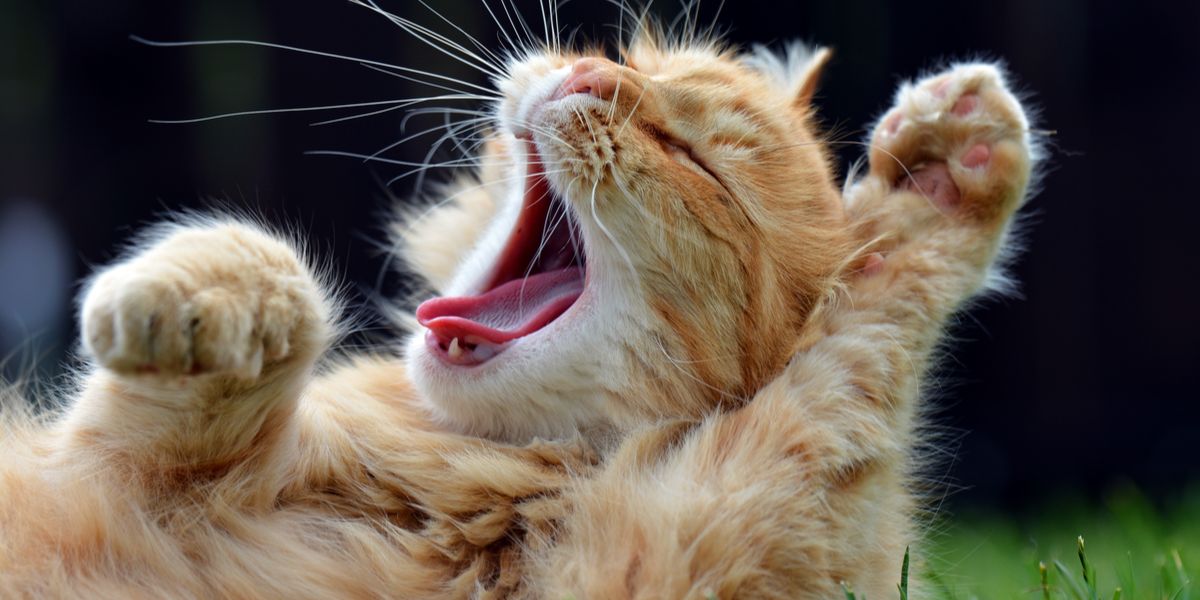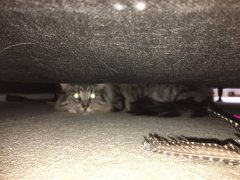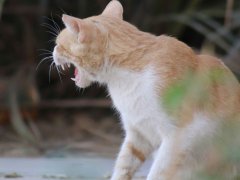
Our cats are fascinating creatures with an extensive vocal repertoire consisting of many amusing sounds such as chatter, chirp, tweet, and meow.
Cats use several communication sensory systems such as visual, olfactory, tactile, and auditory signals to express how they feel. Sometimes it’s tricky to understand cat communication and identify the exact context our cat conveys through vocalisations and other communicative signals.
This article will help you interpret the significance of cat chattering and the intention your cat is trying to convey during chatterbox gatherings.
What Does Cat Chattering Mean?
Cat chatter is usually communicated when prey is unattainable. The cat will often vocalise in a manner known as chittering. The sound is usually produced while the mouth is opened plus closed rapidly, creating a succession of short sounds punctuated by short pauses of silence.
Each cat possesses an individual sound, which differs in pitch and frequency but includes a sequence of clicking-like noises (made from teeth chattering) and/or a string of high-frequency staccato squeaking-like sounds (University of Lincoln and ICatCare 2010).
Theories About Why Cats Chatter
The Kill Bite Theory
An alternative theory for cat chattering is that it simulates the “kill bite” (a predatory behaviour). Cats tend to kill their prey by a bite to the scruff of the neck. They use a “chattering” movement to position their precise bite severing the spinal cord and subsequently killing the prey.
Prey Impersonation
Researchers from the Wildlife Conservation Society (WCS) and Federal University of Amazonas (UFAM) stumbled on an extraordinary calculating behaviour of a wild cat species: the Margay impersonating tamarin monkeys to lure them from their trees within their hunting range in the Brazilian Amazon.
The study suggests that cats might be far more psychologically cunning (Fabio Rohe, Wildlife Conservation Society 2010) which led them to speculate whether household cats able to lure prey by mimicking the chirps and chatter sounds.
Cat Chattering at Birds
When a cat chatters at birds, the cat’s body language indicates it is in a stimulated state since the body is tense, eyes are usually wide-open, the whiskers point outwards away from the face, the tail vibrates and sometimes the skin ripples together with chatter. The cat is preoccupied with the unachievable prey which is too high up in a tree or visible through a window.
Cat Chattering at Human
Although it isn’t as common as chattering at birds, lizards along with rodents, some cats chatter at humans during play time as form of arousal or excitement while others when they are frustrated trying to communicate with their owners.
The frustration can be prompted by a failure to meet their expectations, obtain resources, or retain control.
Largely, housecats mainly communicate with humans, not with other cats and are much noisier than feral cats who don’t need to declare their presence vocally. Cat breeds such as Siamese are extremely intelligent, social, and may chatter relentlessly to obtain their owner’s attention.
A recent study demonstrated a house cat who successfully learned to mimic their humans behaviour and mirror certain actions during cued training sessions which may also suggest that cats can learn how to copycat their owners through vocalisation.
Cat Chattering Due to Pain

It’s speculated that while cats meow and chirp to communicate with humans, vocal communication is not as common in inter-cat relationships.
Oral conditions and dental disease are a common problem in cats however may be neglected at times since cat’s don’t like being handled or their mouths examined. Similarly, cats are masters of disguise and will continue eating despite substantial oral pain and disease.
Also Read: The Complete Guide To Dental Cleaning For Cats
Look out for signs such as excessive dribbling, pawing at the mouth, chattering of the teeth, smelly breath and eating on one side of the mouth. Other painful ailments such as digestive disorders, kidney failure and cancer can trigger teeth-chatter and must be treated by a veterinarian.
Cat Chattering at Another Cat
The hypothesis is linked to the behaviour exhibited during rearing of kittens. Initially, the queen purrs to talk with the kittens until their ear canals open, then the queen calls with a chirping noise when it’s feeding time. Similarly, the kittens react to their mother’s calling when they stray away by returning to the queen for warmth, food and shelter.
It’s important to ensure your cat isn’t doing it too often otherwise it might be indicative of a health issue requiring vet check-up.
More research is required into cat vocalisation since prey-observing cats may use chatter and other kinds of sounds which haven’t been fully examined. In general, many aspects of the cat’s vocal range aren’t properly understood and require further analysis.
Frequently Asked Questions
Why do cats make chattering noises?
House cats’ vocal range is divided into three categories: sounds produced with the mouth closed, sounds delivered with an opening–closing mouth, and sounds created with the mouth held tensely open (Moelk, 1944; McKinley, 1982). Teeth chattering or chatter are fast clicking sounds with the jaws shuddering. Most cats make teeth-chattering noises such as chirp or chatter when they see a bird, squirrel, or mice, whilst others chatter during play with games resembling prey (i.e. toys with feathers).
Some interpret the behaviour as emotional frustration while others as predatory excitement or both.
What is cat chattering?
High-pitched chatter and chirp are widespread vocalisations produced by felines, crickets, guinea pigs and rats. Wildcats can mimic the calls of their prey and this hunting instinct prevailed in the domestic cat. The sound is triggered when a bird or insect prompts the cat’s attention, and the cat starts to chatter or chirp (Schötz, Susanne 2013).
Do all cats chatter?
This is an instinctive cat behaviour displayed by all domestic and wildcats of all ages and breeds.
Why do cats chatter at laser pointers?
Chattering at laser pointers is usually due to frustration-provoking play. An element of irritation can develop if your cat is unable to catch the ‘prey’ and manipulate it. Laser pointers should never be the only source of hunting pursuit, it should be incorporated into a play routine with other toys the cat can catch and ‘kill’.
Why do cats chatter when I sneeze?
We don’t really know why cats chatter when we sneeze. Typically, a cat will jump or run away from a sneeze since they don’t like loud noises.
The most likely explanation is a mimicry behaviour adapted from kittenhood, or a chatty cat is communicating with you by imitating your sneeze or your cat is annoyed exhibiting their displeasure.
-
Ellis, S. (2020). I understand you, do you understand me? Feline communication and implications for human-cat interaction. (pp. 1-7). ISFM. Retrieved October 26, 2020
-
Fraser, A. F. (2012). Feline Behaviour and Welfare. (S. Hulbert, Ed.) CAB International. Retrieved October 20, 2020
-
Heath, I. R. (2016). Feline Behavioral Health and Welfare. St Louis, MO: Elsevier. Page 32-35 Retrieved October 22, 2020
-
Heath, S. (2018). Understanding Feline Emotions and their role in problem behaviours. Journal of Feline Medicine and Surgery, 20, 437-443. Retrieved October 25, 2020
-
ICatCare, U. a. (2010). Cat Behaviour Described. (U. o. Lincoln, Compiler) UK. Retrieved October 21, 2020
-
Schötz, S. (2013, Jun 12-13). A phonetic pilot study of chirp, chatter, tweet and tweedle in three domestic cats. 2-6. (L. University, Compiler) Sweden: Centre for Languages and Literature. Retrieved October 23, 2020, from
-
Shojai, A. (2015). Cat Facts Series 8. In A. Shojai, The Pet Parents A to Z (p. 29). Furry Muse Publications. Retrieved October 19, 2020








What cause a cat not wanting other cats in the house? where can I find a good cat wrap like the vet carry?
Hi Beverly
Thank you for reading our article and for your questions.
Please find my feedback on your questions below:
1. Cats are solitary, territorial animals. They often prefer to be the only cat in a household, as they value their own space and seek attention from their owners. Additionally, cats are not great at sharing resources. Cats that haven’t been properly socialized or exposed to other kittens or cats during their kittenhood are less likely to accept the presence of other cats.
2. You can try the following resources for cat wraps and slings: https://cats.com/best-cat-sling-carriers, https://calmcozycat.com/collections/home-store and https://www.amazon.com.au/dp/B0787M18FK?ref_=mr_referred_us_au_au&th=1
I hope this helps answer your questions.
All the best,
Melina
Where do id get this feliway difuser ?,leaving a shirt behind is no problem.
Hi Peter, here are few links for calming aids and calming treats: https://cats.com/calming-aid-for-cats and https://cats.com/best-calming-cat-treats.
Have a lovely vacation
Melina
MY cat’s separation anxiety, NOt sure about the rabbit ?. I have seen on FB many times,where it’s talking about this issue.
Thanks for your feedback Peter,
To ease your cat’s separation anxiety while you’re on vacation: 1. Purchase and plugin a Feliway Diffuser where your kitty spends most of their time. 2. Leave a shirt with your scent at home or if your cat is in boarding, bring their favorite bowl, bed, blanket, toys, brush and something with your scent from home. 3. Ensure your cat is comfortable in the cat carrier (https://cats.com/how-to-get-a-cat-into-a-carrier) 4. Ensure the pet sitter, friend or cat boarding sticks to your cat’s usual routine. 5. Ensure your contact details are up to date at the vet and the person caring for your cat is authorized to make decisions on your behalf in case you aren’t contactable. 6. Lastly, reduce your own anxiety and talk to your cat while you’re away to reduce their stress level. You can find extra helpful tips on energy medicine at https://www.petnurture.com.au/bodywork-energy-medicine-you-can-help-heal-your-pet/
Hope this helps a little
Melina
I will be going on vacation in November,and I am concerned about separation anxiety.We have a pet Rabbit,will this help our cat with separation anxiety ?.
Hi Peter,
Would you mind clarifying, are you concerned about your Rabbit’s or Cat’s separation anxiety? You can read more about
Cat Separation Anxiety here; https://cats.com/cat-separation-anxiety.
Look forward to your feedback
Melina